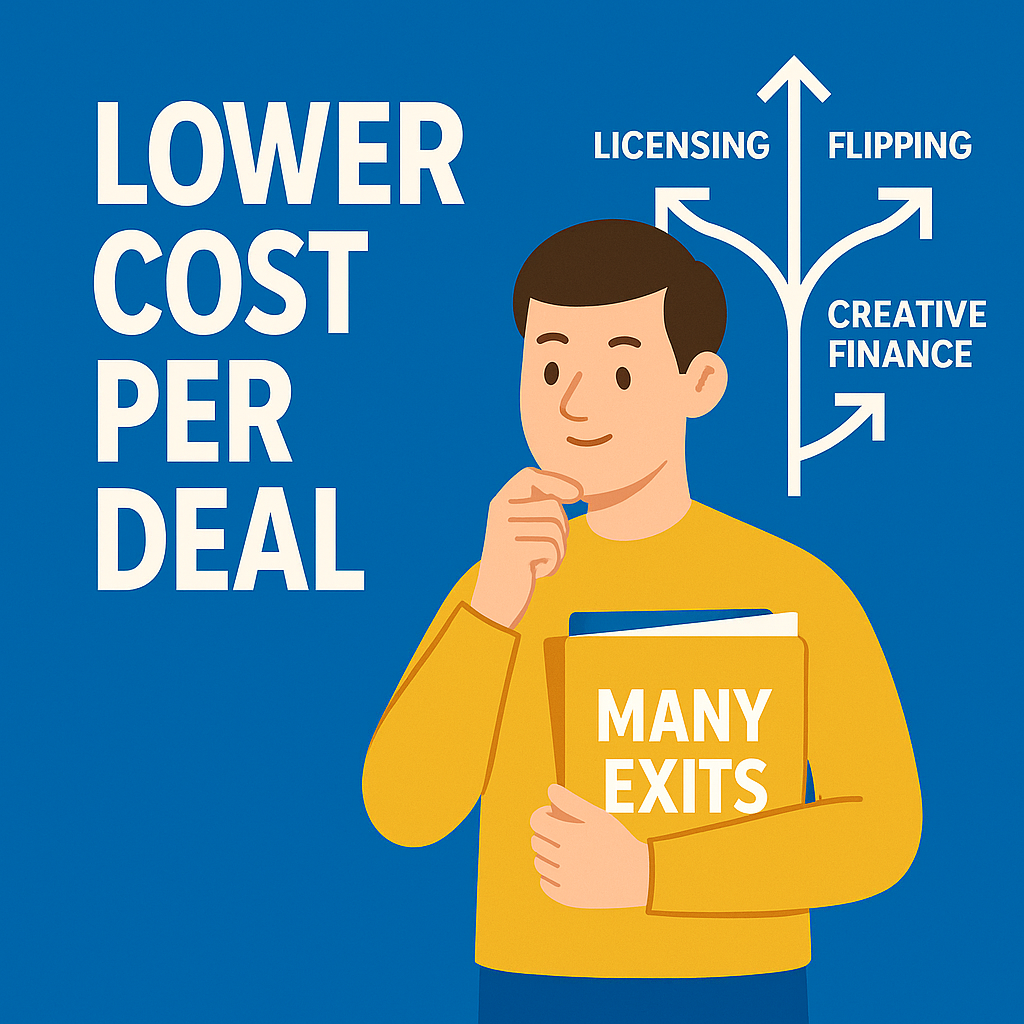If you're a real estate investor struggling with the growing gap between seller price expectations and what your buyers are willing (or able) to pay, you’re not alone. In a market constrained by tight credit and high interest rates, traditional deal structures are falling apart. But there’s a better way forward: creative financing. And nobody understands this space better than Eddie Speed.
With over 40 years of experience and more than 50,000 note deals under his belt, Eddie has pioneered a system that helps investors secure motivated seller leads and structure deals in a way that works for everyone involved.
Who is Eddie Speed?
Eddie Speed began his career in 1980, not as a house flipper or landlord—but as a note buyer. At the time, interest rates were in the double digits, and seller financing was one of the only ways people could sell homes. Eddie saw the opportunity and dove in.
Eddie’s Early Entry into the Business
The seller financing boom of the 1980s—caused by double-digit interest rates—created a perfect entry point. Eddie’s father-in-law and another investor had pioneered the seller finance note buying business, and Eddie joined them. That’s how his journey started.
By the late '80s, he was working closely with real estate investors who wanted to create seller financing but didn’t know how. One of his biggest early clients? HomeVestors. Eddie created their entire note system, and at one point, 60% of all their transactions involved seller-financed notes.
Over time, Eddie went from buying notes to teaching people how to manufacture them, giving investors a "recipe" for creative financing. His methods are now used across the U.S., helping investors navigate a challenging real estate environment.
HomeVestors and the “Blueprint in a Can”
When Ken D’Angelo franchised HomeVestors, he enlisted Eddie to design a repeatable seller-financing process. D’Angelo famously “put house buying in a can,” and Eddie mirrored that philosophy by creating a blueprint that any investor could follow.
Why Creative Financing Matters More Than Ever
Banks aren’t lending like they used to. The Mortgage Bankers Association’s Mortgage Availability Index has plummeted from 185 before the pandemic to around 100 today. That means half the people who could get a mortgage a few years ago can’t anymore.
Rates have doubled. Guidelines are stricter. And real estate investors are left watching deals fall through because buyers can’t qualify.
This is where creative financing comes in.
Future Outlook on Rates and Market Trends
Eddie, who collaborates with a hedge fund managing $30 billion, shared that institutional analytics predict interest rates are unlikely to fall significantly in the near future. This means investors must adapt—creative financing isn’t a trend, it’s a necessity.
By learning to structure seller-financed deals—wrap notes, second liens, subject-to, and more—you can:
- Close deals that others can’t
- Pay sellers closer to their asking price (without taking a loss)
- Sell properties on terms to buyers who can’t qualify traditionally
Understanding the Seller's Mindset
A critical insight Eddie shares is: you need to think like the seller. Not every seller is financially savvy. Many are everyday people who just want to solve a problem—whether that’s retiring, moving, or needing a lump sum.
Asking the Right Questions
Before discussing finances, Eddie emphasizes the importance of getting the seller’s permission and trust. If you skip that step, they may withhold key information—leading to broken deals. Always position your questions as part of helping them.
By understanding their motivations, Eddie developed financing strategies that make sense to the seller, not just to the investor. This is the foundation of creative deal-making.
The Power of Financial Modeling (Without Needing to Be a Genius)
Most house flippers are great at buying low and selling high—but they often lack financial modeling skills.
Eddie has simplified the process by creating spreadsheets and templates that handle the math. Investors just plug in a few numbers, and the system spits out financing options that work.
“You’re not learning from scratch—you’re renting my 42 years of experience.” — Eddie Speed
Collaboration with Sales Experts
Eddie teamed up with veteran trainer Jerry Green to refine how investors pitch creative financing. The psychology behind phrasing—like “Your property might qualify for another program…”—comes from tried-and-tested real estate sales training.
A Sample Strategy: Adjustable Rate Note
Want to offer a seller 1% interest on a $200,000 note? Eddie explains how to structure it so the rate increases over time as the principal decreases—resulting in an effective rate under 2%. It sounds complex, but the strategy is baked into his templates, making it accessible to anyone.
The Real Stats on Zero-Interest Notes
While many gurus promote zero-interest seller financing, Eddie's data shows that only about 14% of sellers actually agree to 0% interest—and even then, usually just for a short term. Most sellers want interest if they’re carrying long-term.
Debunking Seller Financing Myths
Many investors think seller financing is only for:
- Bad houses
- Bad neighborhoods
- Buyers with bad credit
Eddie busts this myth. His students routinely use seller financing to buy $300,000 homes and resell them using wrap notes. It's not about the property—it’s about the terms.
“It’s not what you pay. It’s how you pay it.”
Furniture Store Analogy
To simplify seller financing, Eddie compares it to furniture stores: they sell at retail price and collect payments over time. Sellers immediately grasp this model—making your pitch easier to land.
Wrap Notes and Partial Seller Financing
In today’s market, sellers are rarely carrying 100% of the note. More often, they’re carrying a second lien, while the investor brings in additional financing or assumes an existing mortgage.
Seller Financing Will Mostly Be Second Liens
Eddie estimates that 75% of seller financing in the coming years will be second-position liens, not full seller-carry deals. Understanding how to structure around partial carrybacks is critical.
This structure gives sellers the cash they need upfront—often for immediate life needs—and allows investors to negotiate soft terms on the remaining balance.
Seller Needs Vary (e.g., $10K to Move)
Sellers often need just a small upfront sum—say, $10,000 to relocate—while being flexible on the remainder. By identifying and solving this core issue, you unlock the deal.
How to Pitch Seller Financing the Right Way
Eddie trains investors to ask the right questions that uncover seller motivations. One strategy?
Compare the offer to furniture stores that sell products retail and collect payments over time. Sellers understand that model—it makes seller financing intuitive.
A sample pitch:
“It doesn’t sound like your property qualifies for our standard program, but there’s another one that might get you closer to your price. It’s similar to how furniture companies sell at full price but take payments over time. If you could help me with that, I think we could make this a win-win.”
It reframes the conversation and opens the door to deeper financial discussions.
The System That Makes It All Work
Eddie has developed decision tree paths, which guide you based on seller motivation, equity, and cash needs. Whether a seller can carry 10%, 40%, or 80% of the deal, his system suggests the top six options to structure the financing.
Specific Paths for Carry Percentages
If a seller can carry 10%, your options differ drastically from a deal where they can carry 80%. Eddie’s templates give six likely outcomes based on each carry level—so you know exactly how to proceed.
It removes the guesswork and speeds up deal-making.
Why You Need This NOW
Investor activity is down 30% year-over-year. Wholesalers can’t find buyers who’ll pay like they did before. Hedge funds aren’t overpaying anymore, and traditional buyers can’t qualify for loans.
Hedge Funds’ Retreat and Securitization
Eddie explains that hedge funds were overpaying because they securitized rental properties like pre-2008 mortgage securities. Now, with rate hikes, they’ve changed the numbers in their spreadsheets—and they’re no longer willing to pay top dollar.
This means more sellers are sitting on properties they can’t move—and more buyers are being locked out of the market.
The solution? You guessed it: creative financing.
Learn from Eddie Speed: Free Masterclass
Want to dive deeper? Eddie created a free masterclass that breaks down everything—from case studies to templates.
👉 Access it here: NoteSchool.com/Driscoll
In just a couple of hours, you’ll learn how to:
- Find motivated seller leads
- Analyze deals with decision tree paths
- Structure seller financing creatively
- Open new profit channels from "trash leads"
You May Already Have Seller Finance Leads
Eddie believes many investors already have viable creative deals sitting in their CRM trash bin—leads that were rejected simply because they didn’t ask the right questions.
Key Takeaways
- Creative financing is essential in today’s market due to rising interest rates, limited mortgage availability, and a decline in investor activity.
- Eddie Speed has 40+ years of experience and has closed over 50,000 note deals, making him one of the most trusted voices in seller financing.
- Seller financing isn’t just for distressed properties—it’s a powerful tool for acquiring quality properties in all markets when structured properly.
- Most upcoming seller financing deals will involve second liens, not full carrybacks, making partial seller financing strategies crucial.
- Understanding the seller’s mindset is key—most sellers aren’t financially trained, so structuring terms that make sense to them builds trust and increases conversions.
- Only 14% of sellers agree to zero-interest notes; most expect some form of interest, but Eddie’s templates help structure low-effective-interest deals anyway.
- Financial modeling is simplified through Eddie’s decision tree paths and plug-and-play spreadsheets—no advanced math skills needed.
- Wrap notes and adjustable rate notes are among the most effective creative tools Eddie teaches, allowing investors to make higher offers without hurting returns.
- Positioning and psychology matter—Eddie’s training (in collaboration with Jerry Green) teaches how to present creative financing like furniture payment plans to gain seller approval.
- Many investors are sitting on dead leads that could be revived through creative financing. With the right questions, those leads can turn into closed deals.
- The real estate market is shifting, and hedge funds are pulling back due to rate hikes and new yield thresholds. This opens the door for nimble investors with creative strategies.
- Eddie’s free masterclass at NoteSchool.com/Driscoll offers a complete blueprint—case studies, templates, and actionable strategies for implementing creative financing now.
Start Building Wealth with Creative Financing
If you’re still relying solely on cash offers or wholesale deals, you’re leaving money on the table—and watching leads die on the vine.
The market has changed. The financing game has changed. It’s time you changed with it.
Tap into Eddie Speed’s proven playbook. Learn how to structure offers sellers say “yes” to. Create value where others see dead ends.
👉 Take the next step: Sign up for Eddie’s free masterclass at NoteSchool.com/Driscoll and learn how to generate motivated seller leads and close more creative deals today.






